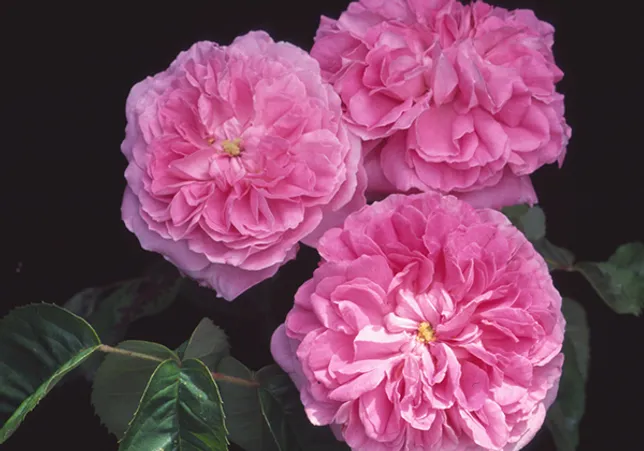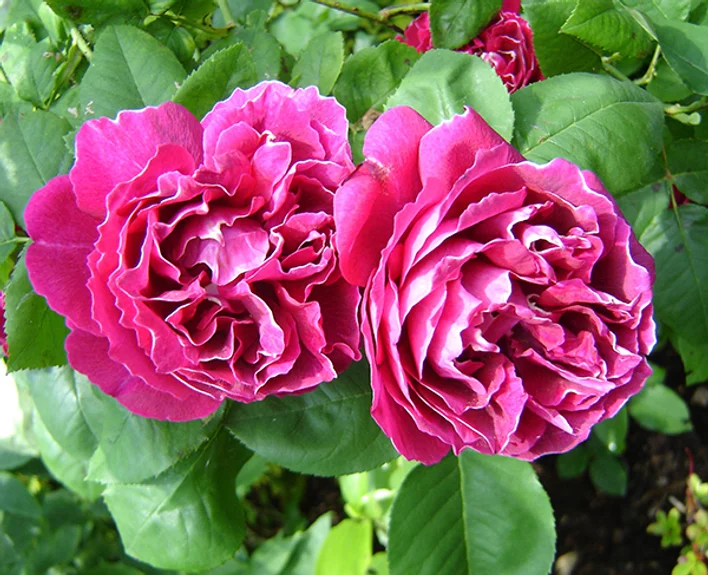by Mirjana Toyn, Consulting Rosarian, Connecticut Rose Society
This is a 2014 AOM article

Hybrid Perpetuals are easily the Heinz 57’s of Old Garden Roses. They represent remontant roses that developed from Hybrid Damask crossed with Bourbons, Portlands, Chinas or Teas. Finally, in 1842 a new class was created for them with the introduction of ‘La Reine’. The Victorians became obsessed with these roses and started an exhibition craze, focusing on the beauty of the individual bloom. In Germany, Peter Lambert continued to breed them until 1936, despite the fact that Hybrid Perpetuals had become eclipsed by the new Hybrid Teas as the focus in exhibition shifted away from fragrance to form. ABOVE: Baronne Prévost (Hybrid Perpetual), by Rich Baer
Experts seem to agree that there are five distinct lineages for these beauties, all of which have somewhat different growth habits. The smallest grow around 4 feet, but the more vigorous varieties will easily reach 8 feet. Bloom forms also vary wildly from pointy with high centers to blowsy, and what can only be described as disheveled at best. Some, like ‘Roger Lambelin’ also have serrated petals. This explains why it was so difficult to include them into any existing classification!

They are blessed with sumptuous fragrance, with only a few notable exceptions like ‘Baroness Rothschild’ and her descendants. Hybrid Perpetuals are amongst the most hardy rose classes (some people apparently grow them in zone 4) and perform superbly in cooler summer climates. Their colors range from pure white to every shade of pink, red and purple you care to imagine. ‘Frau Karl Druschki’ is still considered one of the most perfect white roses of all times. I was lucky to get a $1 bare root specimen a few years ago and can attest to its beauty and large bloom size. It is one of the last roses to flower in my garden, and a few years ago, it continued into the first week of December! Extreme heat stresses them and it is advisable to plant them in a location that gives some reprieve from the hot midday sun. This holds true particularly for purple and dark red varieties like ‘Souvenir du Docteur Jamain’, whose petals can scorch. The most spectacular bloom happens in June and a secondary, less opulent flush occurs at the end of summer. ABOVE: Baron Girod de L’ain (Hybrid Perpetual) by Mirjana Toyn
When I was still an inexperienced rose grower I foolishly planted mine in mixed borders, and I am now suffering the consequences as the perennials and shrubs grow ever more vigorous, sapping the energy of these roses. Hybrid Perpetuals are extremely greedy feeders and require breathing space around them to accommodate their size and to help prevent fungal disease. Severe pruning is also resented and you might suffer serious dieback if you are too enthusiastic with the clippers! I prefer to peg mine or train them laterally like small climbers when dealing with long canes.

Some of the more popular varieties in my garden include ‘Baron Girod de l’Ain’ with its serrated red petals and white picoté edging, mauve and nearly thornless ‘Reine des Violettes’, stripy pink and blush ‘Ferdinand Pichard’, cerise ‘Paul Neyron’ with its large flowers and pink ‘Baronne Prévost’. ABOVE: Ferdinand Pichard (Hybrid Perpetual) by Rita Perwich
Strangely enough, they are more readily available in nurseries in the United States than in Europe. The gardens at Sängerhausen and Roseraie de l’Hay both have nearly 500 different varieties of Hybrid Perpetuals. Occasionally you can find them as bag roses at Home Depot or Ocean State Job Lot in late spring.
The beauty and scent of these old girls remains undiminished over the centuries and no rosarian should refuse them a space in the garden. You are spoiled for choice regarding size, bloom shape and color, so you might need to buy multiple varieties!




























































